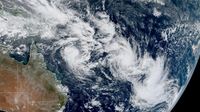As tropical cyclone Alfred wreaks havoc across coastal areas of Queensland and New South Wales, a new report from the Climate Council has sounded an alarm about the increasingly costly repercussions of extreme weather on local communities. On March 20, 2025, the report illuminated how extreme tropical weather events are expected to escalate, leading to substantial expenses and catastrophic disruptions for residents.
The situation is dire: four million Australians found themselves directly affected by Alfred, which brought down power lines and inflicted damage on roofs, prompting a staggering 3,676 emergency calls to Queensland's State Emergency Service (SES). In addition, about half a million homes and businesses lost power, marking a severe infrastructure underbelly laid bare by ongoing climatic challenges.
“In Queensland, every local government area that faced a disaster warning for Alfred also experienced flooding in 2022, and NSW communities such as Clarence Valley, Mid-Coast and Port Macquarie-Hastings have been battered by a series of floods, fires, and storms since 2019,” said Climate Council CEO Amanda McKenzie. She emphasized the repetitive agony inflicted on these communities, which are “forced to clean up the mess of climate pollution again and again.”
The financial fallout from Alfred cannot be underestimated. Economists are projecting a $1.2 billion hit on the federal budget due to the storm, which threatens to further inflate the economy as taxpayers bear the brunt of clean-up costs. “The average cost to Australian households of extreme weather in 2022 was $1,532, with this expected to climb to more than $2,500 per household by 2050,” noted Climate Councillor Nicki Hutley. She further remarked that each significant climate disaster spikes living costs and exacerbates insurance premiums. It’s worth noting that Australians are now paying an average of $30 billion more for insurance today than a decade ago.
Add to that the current wave of insurance claims, which already number over 63,000 amidst the devastation left by Alfred, and you get a grim picture of ongoing financial strain. Travelers have also felt the pinch; Southern Cross Travel Insurance reported 37 claims from Australian customers as of March 13, 2025, highlighting that disruption is also rearing its head in the context of global and domestic travel.
“Extreme weather events caused by climate change are increasing, resulting in more disruptions internationally and domestically,” stated SCTI CEO Jo McCauley. The stark reality gives way to forecasts predicting storms to become less frequent but more severe, with significant implications for densely populated coastal regions.
Meanwhile, as the dust settles on cyclone Alfred’s unprecedented destruction, property owners face unexpected challenges with insurance claims stemming from damaged roofs. More than 41,000 claims have been lodged, yet a little-known insurance clause requiring proof of roof maintenance has left many residents grappling with denied claims.
David Baird from Prestige Home Transformations shed light on the issue, urging homeowners to stay proactive about roof upkeep. “If your roof isn't maintained properly and water gets in, it can cause all sorts of damage.” Recognizing the necessity for regular inspections might save homeowners substantial sums in the long term.
The governmental response has included limited disaster assistance payments—$1,000 per adult and $400 per child, with an additional $180 emergency hardship payment from the state government. However, many feel these numbers barely scratch the surface of the financial needs for complete restorations, leaving many questioning the effectiveness of the support.
“It’s devastating that these communities are being forced to clean up the mess of climate pollution again and again and again,” concluded McKenzie, encapsulating the ongoing frustrations residents face as the adversities of climate change hit home. Her words echo the urgent call for a shift in policy that addresses both preventative measures and damage control in the face of rising weather extremities. As discussions about climate action continue, the reality on the ground reaffirms the need for swift and proactive approaches to stave off future catastrophes, both environmentally and economically.



